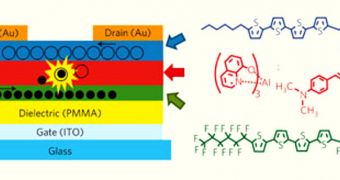For many years, optical physicists have been trying to produce a class of advanced instruments known as electrically-pumped organic lasers, which could be used for a variety of applications. Over time, several groups attempted to use organic light-emitting diodes (OLED) to achieve this purpose, but the efficiency these light sources have left to be desired. Now, a research team from Italy may have broken the limitation, by creating organic light-emitting transistors (OLET). These devices are a lot more efficient than OLED, and they can provide a light source that endures for much longer.
The scientists that made the finding are based at the Institute of Nanostructured Materials, in Bologna, and were led by expert Raffaella Capelli. The team explains that an OLED device is essentially a semiconductor material made from organic compounds, consisting of a thin film. This structure is capable of emitting photons (producing light) when an electrical current is applied via two electrodes. Possible applications for these diodes include lighting and advanced electronic displays, and they are being used in these fields to great success.
However, they fall short when it comes to being used for organic laser applications. Their efficiency is severely reduced by physical phenomena such as photon loss at the electrodes, as well as by exciton-charge interactions. This is why physicists have been focusing on using transistors instead. These are also semiconductor devices, and they are generally used in electronic circuits, for amplifying and/or switching signals on and off. They are extremely efficient at what they do and do not allow for photon loss, which in practice translates into more light being produced.
The new OLET features a light source just several micrometers in size, but which maintains light production separate from the usual tasks of the transistor (amplifying and switching). The light produced in this manner is both bright and efficient, and therefore suitable for use in electrically-pumped organic lasers. When they are produced, these lasers will immediately find uses in the telecommunications industry, especially in the field of fiber optics-based signal transmission, Chemistry World reports.
The 5 percent external quantum efficiency of the new devices “greatly exceeds that of previous OLET and is also twice the efficiency of the equivalent optimized small molecule OLED using the same materials. This is a very important efficiency milestone,” says of the achievement OLET expert Alasdair Campbell, who is based at the Imperial College London, in the United Kingdom. He was not involved in the new study.

 14 DAY TRIAL //
14 DAY TRIAL //